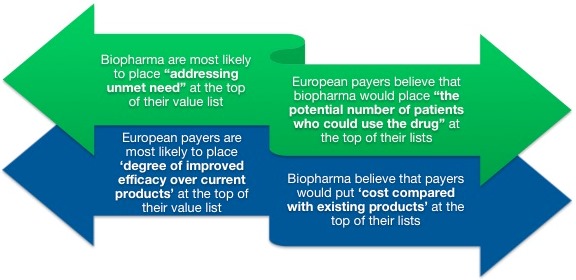Market Access & Pricing Excellence 2015
Co-create solutions with payers. Get reimbursed for real patient value.
The impact of value misalignment on patient outcomes
Biopharma's success in the new healthcare economy is focused on a clear guiding principle: prove the value of the product to all stakeholders, or risk commercial failure.

In the UK, the number of budget holders has vastly increased, with NICE, NHS England, the Cancer Drug Fund and the proliferation of clinical commissioning groups all now demanding drugs that deliver exceptional value.
However, meeting those demands means biopharma needs an extremely thorough understanding of how a myriad of payers and providers individually define what they mean by 'value'. In theory, any definition must align with the 'triple aim' – to improve population outcomes and enhance quality of life, while simultaneously lowering healthcare costs. Yet in the real world, definitions are far from consistent.
Tracking the misperceptions of value
A Quintiles analysis of the value stories of payers, providers and biopharma has revealed a major disconnect that threatens not just the market success of products, but more importantly, the quality of patient care and outcomes.
The survey probed the beliefs of over 100 biopharmaceutical executives at or above vice president level, and almost 200 payers and providers across the UK, France, Germany, Italy, Spain and the US. The findings – published in the Value is the Target report – revealed highly disparate views that give credence to the argument that biopharma must make relationship-building with stakeholders a high priority, or risk commercial failure.
Figure 1: The value misalignment

The danger and implications of mistrust in stakeholder relationships
The findings in Figure 1 clearly demonstrate a jarring disconnect, but more concerning is the picture of mistrust that also emerges from the data. More than half of European payers say they are ‘not at all confident’ or ‘not very confident' in biopharma’s claims about value. An almost equally high number of payers say they are ‘not at all’ or ‘not very confident’ in the reliability, completeness and transparency of information biopharma provides to demonstrate value.
This lack of trust may therefore inhibit biopharma’s ability to gain influence or win support from stakeholders even if their value messaging is genuine. If proof of value is a major driver when healthcare decision-makers select treatment options going forward, biopharma must work hard to reverse this skepticism. They must work collaboratively with other stakeholders to develop the trust necessary to support greater data transparency across the industry, or risk losing their competitive edge.
The impact on patient care
A mismatched value story can negatively impact on service development, can misinform pathway design, lead to poor take-up and adherence, and ultimately, commercial and clinical failure".
It is essential that these misperceptions, combined with concerning levels of mistrust, must be seen in the wider context of healthcare. This disconnect does not merely create obstacles that lengthen time to market, but rather is in danger of outright blocking patients' access to the medication they need. A mismatched value story can negatively impact on service development, can misinform pathway design, lead to poor take-up and adherence, and ultimately, commercial and clinical failure.
Just as important though is the fact that misalignment and mistrust inevitably stands in the way of the kind of NHS and biopharma joint-working that we know is essential to maximize the value of a drug in a real world environment. If the two are aligned, biopharma is able to provide highly targeted resource and support on the ground. Yet if not, opportunities to understand the real world value of a drug, understand and refine patient experience and outcomes, and potentially reduce the overall cost burden to payers through pathway redesign will be lost.
Biopharma-funded joint-working can be the catalyst for changes that ultimately redefine patient care, processes and pathways, and long term cost of care. If providers and payers feel the data/value argument is unreliable, then working in partnership in a real-world patient environment to augment that data is essential.
Blueprint for action: transparency and genuine collaboration
These findings clearly emphasize the need for more cross-industry discussions about value that involve all of the stakeholders, including patients. Determining how the healthcare industry can work jointly to identify and deliver value-driven solutions, and to communicate that value to healthcare decision-makers should be a priority.
Currently, the misalignment surrounding biopharma's definitions of value underscore the misperceptions of other healthcare stakeholders. If payers and providers believe biopharma prioritizes access to patients over improving quality of life or delivering more effective treatments, relationships will be damaged and ultimately, patients may not receive the quality medications they need.
A successful relationship-building strategy could include:
- Taking risks in clinical development to only develop new products that offer meaningful clinical superiority to the existing standard of care
- Monitoring regulatory, financial, and social trends relating to value and healthcare, and using that information to shape the product portfolio. Pursue products that offer the greatest value proposition for the most stakeholders to ensure their broad success
- Making value a measure of progress from the outset, demonstrating through real-world research, Phase III trials, and industry partnerships how the product will deliver value to all healthcare stakeholders
We are seeing many of these strategies being considered and in some instances they are in the early stages of implementation. These considerations are critical as local healthcare economies cannot function effectively if key stakeholdersmaintain such disparate views on value. It is in all parties’ best interests to realign their beliefs and deliver value-driven products that improve patients’ quality of life.
To view the presentation Paul delivered at this year’s eyeforpharma Value Added Services Summit entitled ‘Value is the target: Aligning value for payers to pharma', click here.
About the author
Paul Sutton is the Director of Outcomes and Value, Commercial UK, where he leads the design and implementation of health informatics, data analytics, service pathway evaluation and modeling, and patient outcome audit service: to help pharmaceutical clients (and their NHS stakeholders) understand, realize and demonstrate real-world outcomes and value for their brands at a local health economy level in the UK market. Prior to Quintiles, Paul held key positions with Bupa Home Healthcare, developing value-added services for pharma; and with Bupa Health Dialog as a senior management consultant to NHS clients. Paul worked in the NHS for 12 years, culminating in senior commissioning roles in NHS Manchester. Paul received his Bachelor of Arts and Master of Arts degrees from Oxford University.
Market Access & Pricing Excellence 2015
Co-create solutions with payers. Get reimbursed for real patient value.
